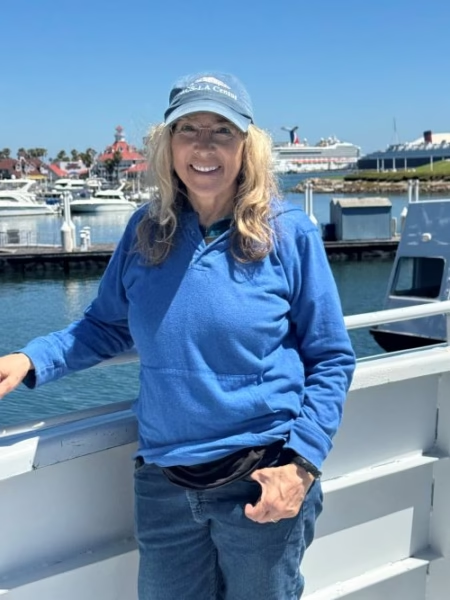One Woman’s Mission in a Warming World
By Evelyn McDonnell
Alisa Schulman-Janiger remembers her first visit to what was then the Cabrillo Marine Museum (now aquarium) in San Pedro. On a kindergarten field trip, she watched as a charismatic instructor shimmied his body in what he called “the grunion dance.” The 5-year-old realized he was imitating the tiny fish she had been collecting at the beach while her father body-surfed. Laughing at the mustachioed man’s enthusiasm and taking in his knowledge, she thought maybe this was something she could do when she grew up.
“I already wanted to be a clown to make people laugh, but John Olguin inspired me to be a teacher,” she says. “And I really wanted to teach about marine life.”
Schulman-Janiger not only spent 21 years teaching marine science at San Pedro High School, among other places; she also wound up frequently working alongside Olguin, the legendary founder of the aquarium, the Cabrillo Beach fireworks, and so many other San Pedro institutions. Among his accomplishments, the Mexican-American environmentalist and educator founded the Cabrillo whale watch, helping to raise public awareness of the migration of gray whales up and down the Pacific coast. The once-hunted species became California’s state animal and rebounded to a peak population of 27,000 in 2016, 5 years after Olguin died.
Schulman-Janiger now watches those numbers plummet. In 1984 she grew a fledgling volunteer whale census at Point Vicente into an annual December to May count. The American Cetacean Society LA Gray Whale Census and Behavior Project tally that ended this May recorded the lowest annual migration numbers since it started, 130 southbound and 485 northbound. The National Oceanic and Atmospheric Association estimates that there are currently between 11,700 and 14,450 North Pacific gray whales – less than when they began tracking the species in 1968. The culprit: lack of food in the cetaceans’ Arctic and subarctic summer feeding grounds, due to warming waters caused by climate change.
“The problem is their dependable food are the amphipods. That’s like when you open up your refrigerator, you’ve got food in your refrigerator. They expect it. It’s always there. Now they open up their refrigerators and there’s nothing there,” Schulman-Janiger explains, cloaking zoological nerdiness in a daily-life analogy – the hallmark of a citizen scientist.
Sitting on the upper deck of a Harbor Breeze whale-watching boat in Long Beach, Schulman-Janiger methodically covers herself from head to fingers to toes in blue. Blue ACS cap covered by hood of blue sweatshirt. Lightweight blue pants. Blue sneakers, blue gloves. “I am blue,” she says. It’s as if she loves the ocean with such an intensity that she becomes one with it. The immersion in cerulean is also necessary: She spent much of her life blissfully and blithely soaking up the sun in the years before research proved that such exposure could be deadly, especially for fair-skinned people like Alisa. Having already lost patches of flesh to cellular deformity, she swathes with white lotion the few parts of her body that aren’t covered in cloth.

Schulman-Janiger is one of those people who seems to always be facing or seeking the ocean, her face drawn like a compass needle by the magnetism of the waves, her blue eyes scanning and reflecting the horizon. Call them children of John Olguin: Citizen scientists who dedicate their lives to deepening our understanding of the Pacific and its inhabitants. Born in Long Beach, she began visiting the beach as a baby; her father was an avid body surfer and she inherited his love of water and nature. The first time her parents set her in the surf, the 18-month-old she did not want to leave. She learned to swim soon after. “I’d swim five days a week. My passion was water in all of its aspects.”
Schulman-Janiger grew up at a time when prominent wildlife experts beamed into suburban homes weekly from exotic locations. Her eyes were glued to the TV as Jacques Cousteau went face to face with fish and Jane Goodall hung with chimpanzees. “I admired her way of connecting with the animals and seeing them as individuals, and not like animals, but as persons in the forest,” Alisa says of Goodall. At a visit to Marineland, the water park on the Palos Verdes peninsula that closed in 1987, she fell in love with bottlenose dolphins and killer whales. “I would see whales as people of the ocean.”
The water baby turned her avocation into her vocation: lifeguarding, teaching swimming, going out on boats as an educator, identifying and photographing marine mammals, teaching adolescents marine biology, etc. Schulman-Janiger, who has a degree in zoology with a focus on marine biology from Cal State Long Beach, has spent her entire life in Southern California, except for two summers when she worked as a naturalist on whale-watching boats in Massachusetts. Her research is in the field more than the lab – or rather the sea is her lab.
“My passion was the ocean and being out with the animals and learning more about them, particularly whales and dolphins…. I was really interested in tracking a particular being in its lifetime, and looking at its connections, its associations, its life, its loves.”
Alisa herself fell in love out in the field. She spotted her future husband at her first necropsy of a whale corpse, on the shore of San Pedro Bay. Alisa Schulman married David S. Janiger 13 years later; he manages the Marine Mammal Collections at the Natural History Museum of Los Angeles, where Alisa has taught. The couple lives in Point Fermin.
Following in the footsteps of Olguin, Cousteau, and Goodall, Alisa chased that spark she first felt at 5-years-old: to pass along her aquatic knowledge and enthusiasm. At San Pedro High, she schooled a generation of young people on the anatomy of pinnipeds and the cries of humpbacks.
“She can speak whale!” says Sandra Martin Alvarenga, who just retired from directing the marine science magnet at SPHS. “Her passion for marine science is kind of unprecedented. She took what students wanted to learn to all new heights. She’s just able to infuse her own passion and break down knowledge in a way that makes it accessible for kids.”
Jillian Shundo was one of those students. “I really appreciated her hands-on approach to teaching us about marine life through visits to our local tide pools, harbor boat trips, beach clean-ups, and in-class experiences with the animals,” says Shundo, who now works at the Aquarium of the Pacific. “I recall a memorable squid dissection that turned into a cooking class as we learned about cephalopods and transformed the remaining tentacles into a delicious calamari appetizer to also practice sustainability.”
On the boat, Schulman-Janiger draws a figure in the air then exclaims “49B.” She’s identifying a killer whale in her head based on the shape of its dorsal fin and the corresponding designation it has been given by researchers. She also knows the orcas by name, whipping out a phone with a photo of Star that she took on one of her many memorable ocean adventures. As lead research biologist of the California Killer Whale Project, she can tell you the date Star was first identified and Star’s children as well.
Sometimes the scientist and the humanist come into conflict. One of her cherished subjects – killer whales – likes to feed on the babies of one of her other favorite species, gray whales.
“Although it’s important for the killer whales to be able to take down the calf and feed their young — it’s very important to pass on those hunting skills — I’m really torn because I’m also team gray whale. … I don’t enjoy watching that at all. It’s interesting from a scientific perspective. It’s important to know the details.”
Alisa’s life goal seems to be to spend as much time in or on the ocean as on land. The week we went whale watching from Long Beach, she had been on the water almost every day. She is a member of a network of marine mammal enthusiasts. With the government gutting funding for agencies such as NOAA and for universities, the present and future of ocean life increasingly lie in the hands of citizen scientists like her. NOAA maintains its own gray whale census, but its future is uncertain. Alisa’s team of volunteer observers in Palos Verdes may have to hold the line in the local coastal battle for cetacean knowledge and interspecies support, until our country gets its mind back.
It’s windy on the day we sail from Long Beach and we don’t spot any whale blows among the whitecaps. We do hang out with a pod of short-beaked common dolphins for a while. It’s a big ship full of families, and children scream with delight as the animals surf the wake, babies following their mothers. Schulman-Janiger believes this engagement of young hearts and minds validates the somewhat questionable business of chasing after animals on boats with giant engines.
“That’s what I loved about working on the boat program, versus the classroom,” she says. “The classroom was great to get in depth with specific kids. On the boat program every day I had different kids, and sometimes it’s the first time they saw the ocean.”
Alisa has a long lens on her Canon camera and she moves from one side of the boat to the other, snapping away. Photography is another passion of hers; she has sold her images to publications and at fairs. But mostly she documents. She shares her photographic evidence with her network of trackers up and down the coast. Sometimes a gray calf she photographs off Palos Verdes shows up in British Columbia a couple weeks later. She also provides images to Happy Whale, the website that compiles global sightings of cetaceans and is another example of institutional researchers, citizen scientists, and technology transforming our understanding of our planet.
A petite woman with long, blond hair, Schulman-Janiger has had a series of injuries that forced her to retire from teaching and kayaking. As we get ready to leave the boat, she hoists a heavy-looking pack onto her back. I offer to carry her shoulder bag, but when I try to lift it, the camera equipment defeats my strength. “That’s okay, I’ve got it,” Alisa says, swinging the strap over her head. As we clamber down the noisy steel gangplank, I disembark the boat with doubled appreciation for my guide’s knowledge and strength.
“I want people to be able to go out and see, I want people to be able to experience that joy. That gives me huge pleasure, huge! But it’s doing it in a caring way that doesn’t have a negative impact. It’s the whole thing that Jane Goodall would say, Jacques Cousteau would say: ‘You get to know them. That’s how you get to love them. You get to love them, and you’ll want to protect them.’”
Evelyn McDonnell writes the series Bodies of Water — portraits of lives aquatic — for Random Lengths. She is a journalism professor at Loyola Marymount University. Her book The World According to Joan Didion comes out in paperback July 29.













